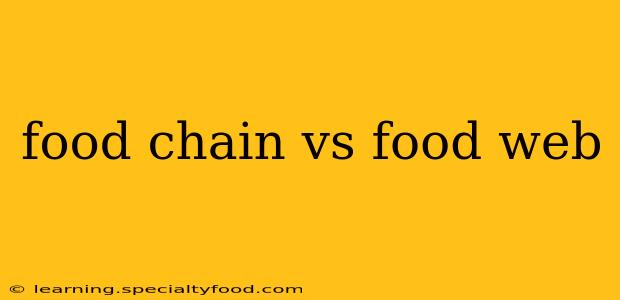The concepts of food chains and food webs are fundamental to understanding the dynamics of ecosystems. While often used interchangeably, they represent different levels of complexity in describing how energy and nutrients flow through an environment. This article will delve into the differences between food chains and food webs, exploring their components and the crucial role they play in maintaining ecological balance.
What is a Food Chain?
A food chain is a linear sequence illustrating the transfer of energy and nutrients from one organism to another. It begins with a producer, an organism that creates its own food through photosynthesis (like plants or algae). This producer is then consumed by a primary consumer (herbivore), which is in turn consumed by a secondary consumer (carnivore), and so on. This process continues until the top predator, the apex predator, is reached. A simple example is: grass → grasshopper → frog → snake → hawk. Each level in the food chain is called a trophic level.
What is a Food Web?
A food web is a more complex and realistic representation of energy flow in an ecosystem. Unlike a food chain, it depicts the interconnectedness of multiple food chains within a community. It shows how numerous organisms interact, with many organisms occupying multiple trophic levels. For instance, a single organism may be prey to several different predators, and may consume various prey items itself. A food web accounts for the interwoven relationships, creating a more accurate picture of the ecosystem's intricate structure.
How are Food Chains and Food Webs Different?
The key difference lies in their complexity:
- Simplicity vs. Complexity: Food chains are simplified, linear models; food webs are more complex, showing interconnected relationships.
- Linearity vs. Interconnectedness: Food chains show a single path of energy transfer; food webs demonstrate multiple paths.
- Realism: Food webs offer a more realistic portrayal of ecosystem dynamics than food chains.
What are the components of a food chain and food web?
Both food chains and food webs share the same basic components, just arranged differently:
- Producers: Autotrophs that produce their own food through photosynthesis (e.g., plants, algae).
- Consumers: Heterotrophs that obtain energy by consuming other organisms. This includes:
- Primary Consumers (Herbivores): Eat producers (e.g., rabbits, grasshoppers).
- Secondary Consumers (Carnivores): Eat primary consumers (e.g., snakes, foxes).
- Tertiary Consumers: Eat secondary consumers (e.g., hawks, lions).
- Decomposers: Break down dead organisms, returning nutrients to the ecosystem (e.g., bacteria, fungi). These are crucial for recycling matter and energy.
How do food chains and food webs help us understand ecosystems?
By illustrating energy flow and nutrient cycling, food chains and, more comprehensively, food webs allow ecologists to:
- Understand species interactions: Identify predator-prey relationships and competition.
- Assess ecosystem health: Detect imbalances caused by changes in populations or environmental factors.
- Predict ecological consequences: Model the effects of disturbances like habitat loss or invasive species.
- Manage ecosystems: Develop conservation strategies and informed management practices.
What is the importance of decomposers in a food web?
The Role of Decomposers in Food Webs
Decomposers play a vital role in recycling nutrients in the ecosystem. Without them, dead organic matter would accumulate, preventing essential nutrients from returning to the soil and being reused by producers. This would severely disrupt the entire food web and lead to ecosystem collapse. They break down complex organic matter into simpler inorganic forms, completing the nutrient cycle and making essential minerals available for producers.
How does a change in one part of a food web affect other parts?
The Ripple Effect in Food Webs
Changes in one part of a food web can have cascading effects throughout the entire system. For example, a decline in a primary producer's population can lead to a decrease in herbivore populations, which in turn affects carnivore populations. Conversely, an increase in the population of a predator can significantly impact the populations of its prey. These interconnected relationships highlight the importance of maintaining balance and biodiversity within ecosystems.
By understanding the intricate relationships depicted in food webs, we can better appreciate the delicate balance of nature and the importance of conservation efforts. The difference between a food chain and a food web is essentially a difference in scale and complexity, reflecting the reality of diverse and interconnected ecological communities.
